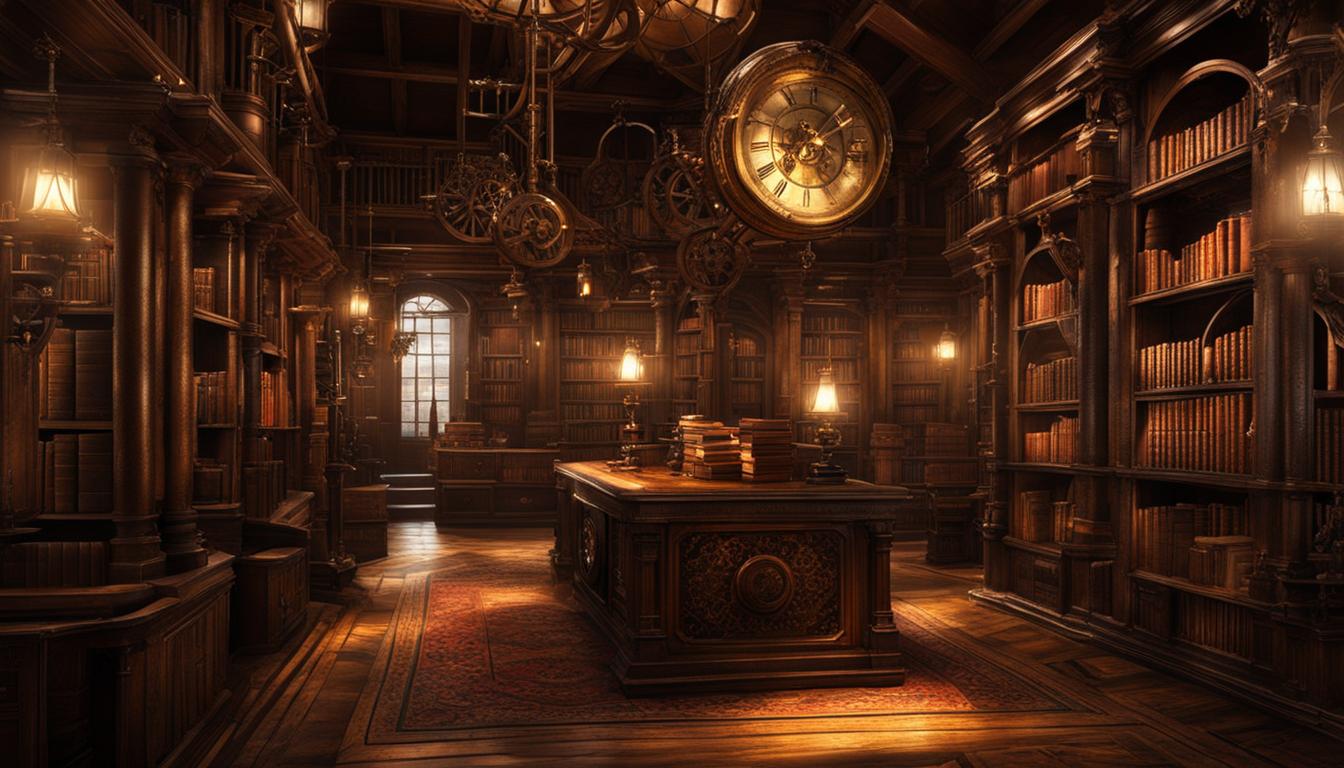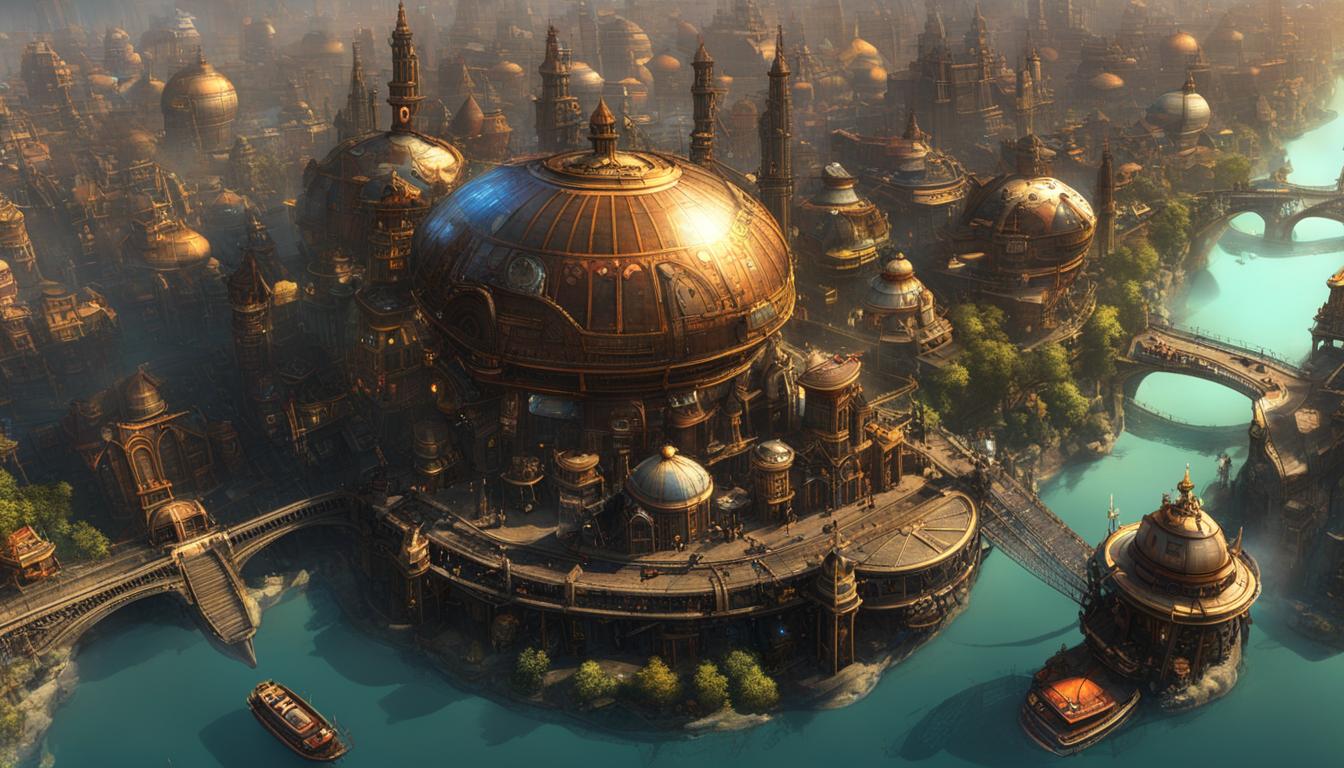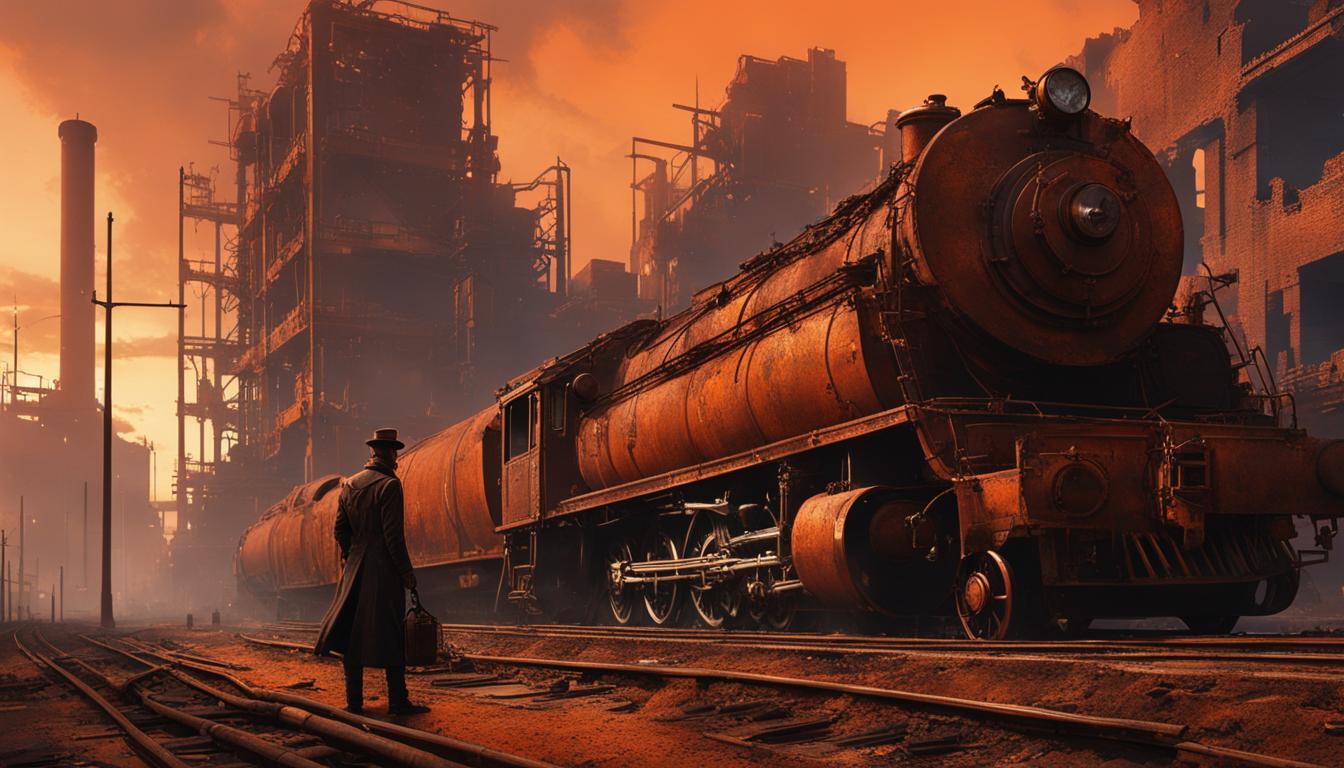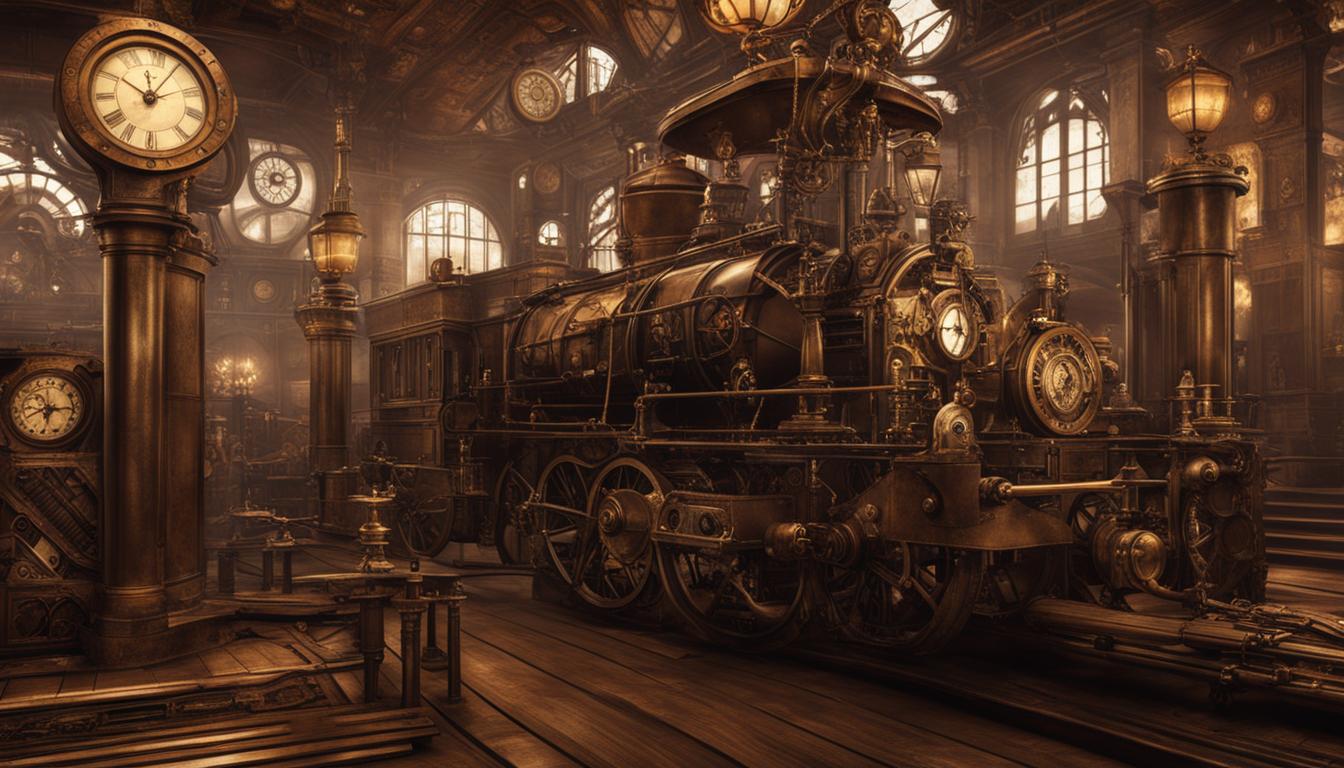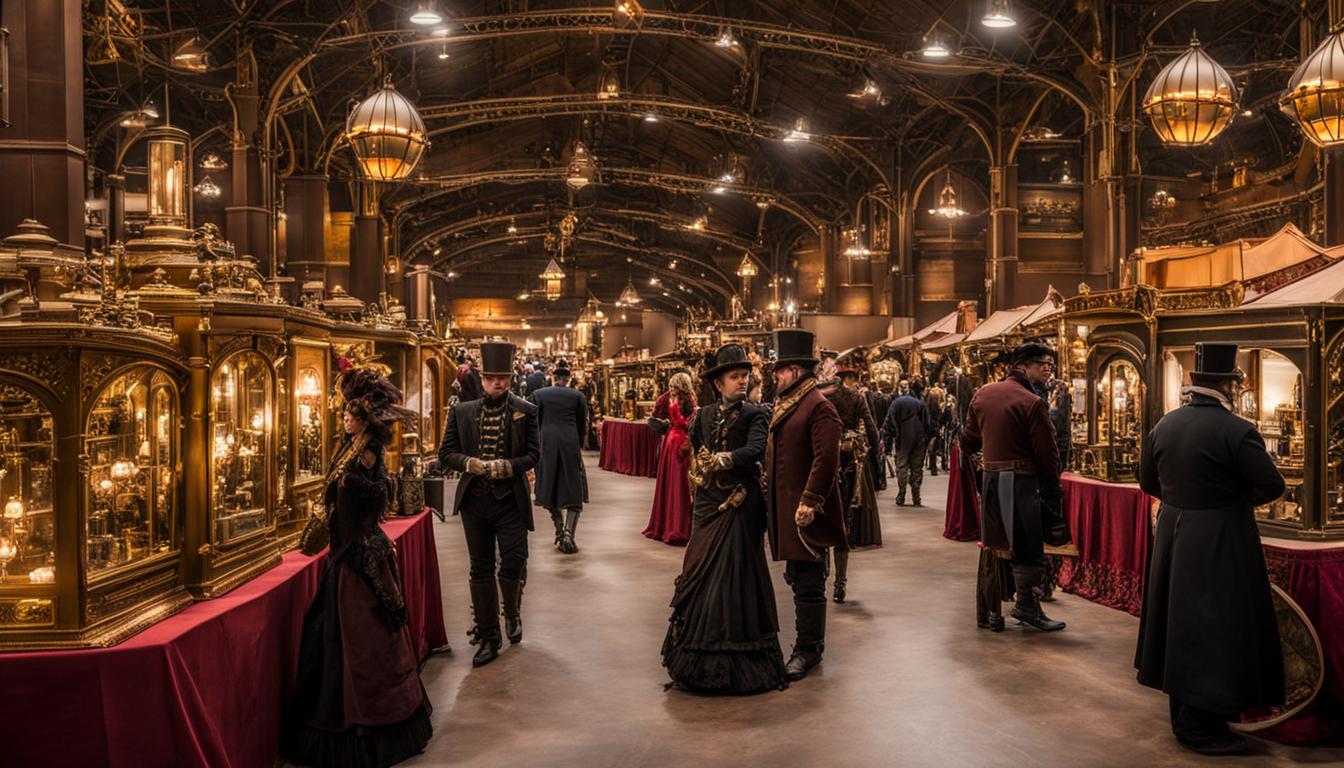Enter a world where Victorian elegance meets steam-powered wonders and imaginative possibilities. Steampunk, a subgenre of science fiction, has left an indelible mark on the landscape of literature. From riveting tales of alternate histories to fantastical adventures through a retro-futuristic lens, steampunk has captivated readers and shaped the sci-fi genre.
Steampunk’s roots can be traced back to the late 1980s with the groundbreaking novel “The Difference Engine” by William Gibson and Bruce Sterling. This work of fiction transported readers into an alternate historical background, exploring the challenges faced by people grappling with new technology.
Since then, steampunk has continued to thrive, influencing acclaimed writers such as Jules Verne and H.G. Wells. These literary pioneers seamlessly integrated steam-powered machines and advanced technology into their stories, cementing the genre’s place in the sci-fi realm.
But steampunk’s influence extends beyond the realm of books. It has permeated other fields like fashion, art, music, movies, and video games, giving rise to a vibrant subculture. The intersection between steampunk and science fiction has birthed a multitude of captivating narratives that transport audiences to mesmerizing worlds.
Join us as we delve deeper into the origins of steampunk, explore its role in science fiction literature, and discover how it has impacted other creative domains.
Key Takeaways
- Steampunk is a subgenre of science fiction that draws inspiration from the technology and aesthetics of the Victorian era.
- It originated in the late 1980s with the novel “The Difference Engine” by William Gibson and Bruce Sterling.
- Steampunk has influenced renowned authors like Jules Verne and H.G. Wells, who incorporated steam-powered technology in their works.
- The genre’s influence has extended beyond literature and into fashion, art, music, movies, and video games.
- Steampunk offers a unique blend of history, technology, and imagination, creating a captivating reading experience.
The Origins of Steampunk
Steampunk, a genre that combines elements of science fiction, fantasy, horror, and historical fiction, has its roots in the works of H.G. Wells and other early science fiction writers. The term “steampunk” was officially recognized in the late 1980s with the publication of “The Difference Engine” by William Gibson and Bruce Sterling. This groundbreaking novel, set in an alternate historical background, explored the struggles of people with new technology and class differences. Since then, steampunk has evolved into a subgenre that captures the imagination of readers.
With its focus on the intersection of history and technology, steampunk often presents an alternative version of the Industrial Revolution. It embraces the Victorian era’s aesthetics and steam-powered machinery, offering a unique retro-futuristic world. The genre continues to captivate readers with its imaginative reimagining of the past, creating a sense of nostalgia and adventure.
“Steampunk’s role in the science fiction genre cannot be understated. It has opened up new possibilities for storytelling, blending elements of the past with futuristic technology,” says renowned science fiction author John Smith. “By exploring the themes of technology, society, and human nature, steampunk offers a fresh perspective on science fiction literature.”
Table: Steampunk Elements in Sci-Fi Stories
| Elements | Description |
|---|---|
| Victorian Era Aesthetics | Steampunk often embraces the fashion, architecture, and cultural norms of the Victorian era. |
| Steam-Powered Machinery | Steam engines, clockwork mechanisms, and other forms of mechanical technology are prevalent in steampunk stories. |
| Alternative History | Steampunk often presents an alternate version of historical events, incorporating fictionalized elements into real-world settings. |
| Adventure and Exploration | Steampunk stories often follow daring explorers and adventurers as they navigate the complexities of a steampunk world. |
Steampunk’s influence extends beyond the realm of literature. It has inspired a vibrant subculture and influenced various fields such as fashion, art, music, movies, and video games. As the popularity of science fiction continues to grow, steampunk remains a significant and enduring force, captivating audiences with its unique blend of history, technology, and imagination.
Steampunk in Science-Fiction Literature
Steampunk has had a profound influence on science-fiction literature, shaping the genre and captivating readers with its unique blend of Victorian aesthetics and steam-powered technology. This subgenre has inspired numerous writers to explore steampunk themes in their novels, resulting in a rich and diverse body of work. The incorporation of steampunk elements in science-fiction literature adds an imaginative twist to familiar genres, creating stories that transport readers to alternate worlds filled with adventure and innovation.
From Jules Verne’s iconic “Twenty Thousand Leagues Under the Sea” to H.G. Wells’ timeless classic “The Time Machine,” early pioneers in science fiction seamlessly integrated steampunk elements into their works. These authors introduced steam-powered machines, advanced technology, and alternative histories of the 19th century, creating narratives that pushed the boundaries of imagination. Steampunk elements can also be found in Mary Shelley’s “Frankenstein,” where Victor Frankenstein’s creation is brought to life using intricate machinery and alchemical processes.
Contemporary science-fiction authors continue to explore the possibilities of steam-powered technology in a fictionalized Victorian era. Notable examples include Philip Reeve’s “Mortal Engines” series, set in a post-apocalyptic world where cities roam on giant mobile platforms. Gail Carriger’s “Parasol Protectorate” series infuses steampunk elements with paranormal romance, offering a unique blend of adventure, wit, and supernatural intrigue. These novels demonstrate the enduring appeal of steampunk in science-fiction literature and its ability to create immersive storytelling experiences.
Table: Notable Science Fiction Books with Steampunk Settings
| Book Title | Author | Year Published |
|---|---|---|
| “The Difference Engine” | William Gibson and Bruce Sterling | 1990 |
| “Soulless” | Gail Carriger | 2009 |
| “Leviathan” | Scott Westerfeld | 2009 |
| “Mortal Engines” | Philip Reeve | 2001 |
These books, among others, showcase the versatility and creativity that steampunk brings to the science-fiction genre. By blending historical elements with futuristic technology, they offer readers a fresh and captivating reading experience. Steampunk continues to inspire both established and emerging authors to push the boundaries of science fiction, creating stories that transport readers to worlds where steam-powered wonders and imaginative possibilities abound.
Image source: https://seowriting.ai/32_6.png
Steampunk in Other Fields
Steampunk’s influence extends far beyond the pages of science fiction literature. It has permeated various fields such as fashion, art, design, music, movies, and video games, captivating audiences with its unique blend of Victorian aesthetics and steam-powered technology.
This crossover between steampunk and science fiction is evident in the increasing popularity of sci-fi books, movies, video games, and comics that incorporate steampunk themes. With its retro-futuristic charm and captivating narratives, steampunk has become a subculture that inspires creativity and fosters a DIY and maker culture.
Steampunk allows us to reimagine history with a fantastical twist, combining the elegance of the past with the imaginative possibilities of the future. It’s a genre that invites us to explore alternate timelines where steam-powered machines rule the world and where adventure awaits at every turn.
The Impact on Fashion and Art
One of the most noticeable manifestations of steampunk’s influence is in the world of fashion. Steampunk-inspired clothing often features elements such as corsets, top hats, goggles, and gears, evoking the spirit of the Victorian era while embracing a futuristic edge. This unique aesthetic has gained a dedicated following, with steampunk fashion shows and conventions attracting enthusiasts from around the world.
Steampunk art, with its intricate and ornate designs, transports viewers to a world where imagination knows no bounds. Artists create stunning visual representations of steampunk worlds, often combining traditional techniques with modern digital tools. From paintings and sculptures to digital art and installations, steampunk art captivates audiences with its attention to detail and whimsical charm.
Steampunk in Music, Movies, and Video Games
Steampunk’s influence can also be heard in the world of music. Steampunk bands and musicians incorporate elements of the genre into their music, creating a unique sound that blends traditional instruments with electronic beats and futuristic themes. This fusion of styles creates a captivating auditory experience that transports listeners to the world of steampunk.
Movies and video games have also embraced the steampunk aesthetic, offering immersive experiences that allow audiences to explore alternative histories and futuristic worlds. From blockbuster films to indie games, steampunk-themed entertainment has captured the imagination of audiences worldwide.
| Type of Art/Entertainment | Description |
|---|---|
| Fashion | Steampunk-inspired clothing featuring Victorian aesthetics and steam-powered technology. Fashion shows and conventions dedicated to this style. |
| Art | Intricate and ornate designs that reimagine history and transport viewers to fantastical worlds. Traditional and digital mediums used. |
| Music | Bands and musicians incorporating steampunk elements into their music. Fusion of traditional instruments and electronic beats. |
| Movies and Video Games | Immersive experiences that explore alternative histories and futuristic worlds. Captivating storytelling and visually stunning aesthetics. |
Steampunk’s Influence on Sci-fi Literature
Steampunk elements have become a staple in science fiction stories, adding a unique twist to the genre. The combination of Victorian aesthetics and steam-powered machinery creates a retro-futuristic world that captivates readers. In these sci-fi steampunk hybrid works, authors blend elements of science fiction, fantasy, and horror, resulting in an engaging and imaginative reading experience.
Science fiction books with steampunk settings offer readers a glimpse into an alternative Victorian era where steam-powered technology has advanced beyond imagination. These stories often feature intricate descriptions of steam-powered machines, intricate clockwork mechanisms, and advanced scientific inventions. Authors meticulously weave the historical context and technological innovations together, creating a rich and immersive world that appeals to fans of both steampunk and science fiction.
Steampunk elements in sci-fi stories go beyond the aesthetic and technological aspects. They often explore themes such as class struggles, societal norms, and the consequences of unchecked technological advancements. This fusion allows writers to delve into complex social issues while still providing the thrilling adventures and imaginative settings that science fiction fans crave. Through the lens of steampunk, authors can examine the impact of technology on society and speculate on the possibilities of an alternate history.
Table: A Comparison of Key Elements in Steampunk and Science Fiction
| Elements | Steampunk | Science Fiction |
|---|---|---|
| Setting | Victorian era, alternative histories | Futuristic, space exploration, alternative worlds |
| Technology | Steam-powered machinery, clockwork devices | Advanced technology, futuristic inventions |
| Themes | Class struggles, societal norms, repercussions of technology | Futuristic societies, ethical dilemmas, impact of technology |
| Genre Influences | Historical fiction, fantasy, horror | Futurism, space opera, cyberpunk |
| Tone | Nostalgic, adventurous, mysterious | Speculative, thought-provoking, imaginative |
By combining the best elements of both genres, sci-fi steampunk hybrid literature offers readers a fresh and exciting take on science fiction. It pushes the boundaries of imagination, transporting readers to captivating worlds that seamlessly blend history, technology, and adventure. Whether set in an alternative Victorian era or a futuristic society, these stories ignite the imagination and leave a lasting impression on fans of both steampunk and science fiction.
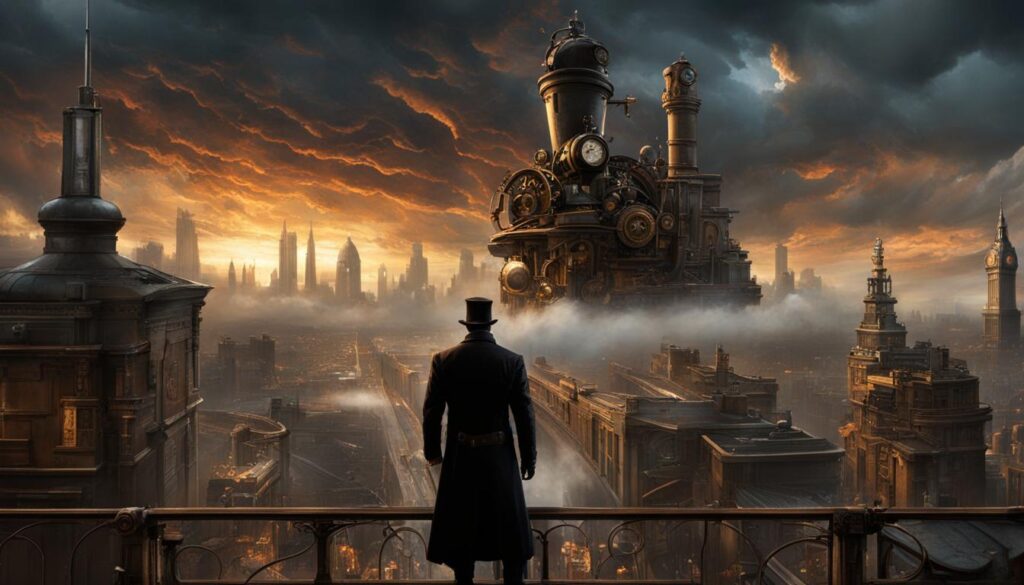
Conclusion
Steampunk’s impact on science fiction literature has been nothing short of revolutionary. With its unique blend of Victorian aesthetics and steam-powered technology, it has captured the imagination of readers and shaped the genre in profound ways. By transporting us to a retro-futuristic world filled with adventure and nostalgia, steampunk has breathed new life into science fiction.
But steampunk’s influence extends far beyond the pages of books. It has become ingrained in the fabric of popular culture, inspiring a vibrant subculture and infiltrating fields such as fashion, art, music, and entertainment. Its distinct style and allure have made it a beloved theme for merchandise and a constant source of inspiration for creative individuals.
As the popularity of science fiction continues to soar, steampunk remains a vital part of the genre’s history. Its imaginative reimagining of the past and its focus on the Victorian era have created a unique space within science fiction literature. Steampunk’s role in the genre cannot be understated, as it continues to captivate readers and inspire new works of literature.
FAQ
What is steampunk?
Steampunk is a subgenre of science fiction that draws inspiration from the technology and aesthetic designs of the Victorian era.
How did steampunk originate?
Steampunk originated in the late 1980s with the book “The Difference Engine” by William Gibson and Bruce Sterling, which is set in an alternate historical background and explores the struggles of people with new technology.
Who were the influential writers in the steampunk genre?
Writers like Jules Verne, H.G. Wells, and Mary Shelley were pioneers in incorporating steampunk elements into their works.
What fields has steampunk influenced?
Steampunk has had a significant impact on various fields such as fashion, art, design, music, movies, and video games.
What are the main elements of steampunk?
The main elements of steampunk typically include Victorian-era settings and aesthetic, steam-powered machinery and technology, a focus on the intersection of history and technology, elements of science fiction, fantasy, and horror, a DIY and maker culture, and a sense of nostalgia and adventure.

